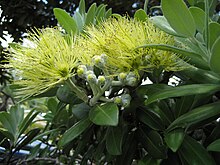Metrosideros excelsa
| Metrosideros excelsa | ||||||||||||
|---|---|---|---|---|---|---|---|---|---|---|---|---|

Metrosideros excelsa |
||||||||||||
| Systematics | ||||||||||||
|
||||||||||||
| Scientific name | ||||||||||||
| Metrosideros excelsa | ||||||||||||
| Sol. ex Gaertn. |
Metrosideros excelsa is a species of the myrtle family(Myrtaceae). It is also called the New Zealand Christmas Tree or, like many other types of plants, also the ironwood tree. The common name Pōhutukawa comes from the Māori .
description
Metrosideros excelsa grows as an evergreen , often multi-stemmed tree that usually reaches heights of 15 to over 20 meters. The mostly large, spreading treetop is round. Solitary larger specimens form aerial roots to better support the protruding crown. The short trunk reaches a diameter of 2 to 3 meters. The brownish to greyish bark is cracked or furrowed or flaky in strips.
The simple, thick-leather and short-stalked leaves are cross-opposite or arranged in clusters and 4–10 centimeters long. They are ovate to obovate, with entire margins and whitish hairy on the underside as well as rounded to pointed.
The hermaphroditic, thick-stalked flowers are five-fold with a double flower envelope . The small sepals, which are densely hairy whitish on the outside, are triangular on a flower cup that is densely hairy on the outside . The small petals are reddish. There are many 2.5–3.7 cm long stamens which determine the flower color. The ovary , with a discus on top , is medium-sized with a thick, long and red stylus with a heady, small and flat stigma . A Metrosideros excelsa produces a large number of red flowers, more rarely also yellow flowers. This splendor of flowers covering the whole tree and the period of full bloom in the southern hemisphere summer between mid-December and mid-January led to the name “Christmas tree”. Depending on the location of the specimen, individual flowering trees can still be seen at the end of February.
Small, three-lobed, loculicidal and hairy capsule fruits ( false fruit ) are formed with many small, very light, about 3 millimeters long, narrow seeds.
The number of chromosomes is 2n = 22.
distribution
Metrosideros excelsa occurs primarily in the coastal regions of the North Island of New Zealand , where both single trees and entire forests can be found. The Pōhutukawa tree in Te Araroa near the East Cape is believed to be the oldest and largest tree of its kind in New Zealand at around 600 years old. They are said to be over 1000 years old.
The cultivar 'Aurea' with yellow flowers is descended from some trees that were discovered in 1940 on Motiti Island in the Bay of Plenty .
Danger
In New Zealand, Metrosideros excelsa is endangered by the possum population that was originally imported from Australia to New Zealand for fur production. The possums eat the foliage and buds of the trees and can cause them to die.
Usage and Mythology
Metrosideros excelsa was introduced to the California coast where it has become a very popular street and green space tree. The Friends of the Urban Forest from San Francisco estimate that it is the third most planted tree in San Francisco in the past two decades.
Numerous legends are associated with the Metrosideros excelsa in Māori mythology . According to legend, an old Pōhutukawa at Cape Reinga is the entrance for the spirits of the dead on their way to their homeland Hawaiki .
literature
- Roger Spencer: Horticultural Flora of South-Eastern Australia. Volume 3, UNSW Press, 2002, ISBN 0-86840-660-0 , p. 402.
- RJ Bylsma, BD Clarkson, JT Efford: Biological flora of New Zealand 14: Metrosideros excelsa, pōhutukawa, New Zealand Christmas tree. In: New Zealand Journal of Botany. Volume 52, Issue 3, 2014, doi: 10.1080 / 0028825X.2014.926278
Web links
- Metrosideros excelsa at New Zealand Plants - The University of Auckland (detailed images).
- Pohutukawa photos at Virtual Oceania.
- Pōhutukawa NZ Department of Conservation.
- Data sheet Pohutukawa from Project Crimson (PDF), at Project Crimson.
- Metrosideros excelsa at Useful Temperate Plants.
- Metrosideros excelsa - Datasheet at Pacific Island Ecosystems at Risk, PIER.
- Metrosideros excelsa in the Germplasm Resources Information Network (GRIN), USDA , ARS , National Genetic Resources Program. National Germplasm Resources Laboratory, Beltsville, Maryland.
- Metrosideros excelsa at Flora of New Zealand - Volume I - Indigenous Tracheophyta. Psilopsida, Lycopsida, Filicopsida, Gymnospermae, Dicotyledons .
Individual evidence
- ↑ René TJ Cappers, Reinder Neef, Renée M. Bekker: Digital Atlas of Economic Plants. Volume 1, Barkhuis, 2009, ISBN 978-90-77922-59-0 , p. 215.
- ^ Metrosideros excelsa at Tropicos.org. In: IPCN Chromosome Reports . Missouri Botanical Garden, St. Louis
- ^ Te Araroa and East Cape . New Zealand Tourism Board , accessed September 3, 2017 .
- ^ Murray Dawson and Peter Heenan: Checklist of Metrosideros cultivars . In: New Zealand Garden Journal . tape 13 , no. 2 , 2010, p. 24–27 ( researchgate.net [PDF; accessed December 17, 2019]).
